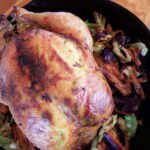Easy Low Histamine Anti-inflammatory Roasted Chicken
This low histamine diet friendly whole roasted chicken recipe is simple to make, full of anti-inflammatory ingredients, and perfect for meal prep. I like to use this recipe as a base for multiple meals throughout the week. After de-boning the chicken, you can freeze in portion sizes to use as needed, add the chicken to soups, salads, stir fries, or wraps. If you tolerate bone broth, you can use the bones for broth, alternatively, you can make some meat broth while this chicken is roasting and make a soup base to pop in the freezer and make weeknight meal prep simple.
Low Histamine Paleo Turmeric Ginger Chicken
Equipment
- Cast Iron Skillet or Roasting pan
- Zester for grating ginger
- Small mixing bowl (for the marinade)
- Whisk or spoon (to mix the marinade)
- Paper towels (to pat the chicken dry)
- Meat thermometer (optional, but highly recommended for perfect doneness)
- Kitchen gloves (optional, for handling turmeric and protecting your manicure)
- Sharp knife and cutting board (for prepping veggies & carving the chicken)
Ingredients
- 1 Whole Chicken (about 3-5 pounds)
- 2 Tablespoons Avocado Oil (or oil of choice)
- 4 Cloves Garlic, Crushed
- 1 Tablespoon Grated Ginger
- 1 Teaspoon Salt
- 1 Teaspoon Granulated Onion
- 1/4 Teaspoon Ground Coriander
- 1 Tablespoon Lemon Juice (Optional-if tolerated)
- 1 Red onion, sliced
- 1 Celery Stick, cut into large pieces
- 1/2 Bay Leaf
Instructions
- Preheat and prep: Set your oven to 425°F (220°C). Remove any giblets from the chicken and pat it dry with paper towels – for crispy skin.
- Mix the marinade: In a small bowl, whisk together the avocado oil, garlic, turmeric, ginger, salt, onion powder, coriander, and lemon juice.
- Season the chicken: Under the skin: Loosen the skin over the chicken breasts (just slide your fingers under there – it’s oddly satisfying) and rub some marinade directly onto the meat. Over the skin: Give the chicken a nice massage with the remaining marinade. Make sure it’s slathered everywhere for maximum flavor.Note: Turmeric is known for its vibrant yellow color, which can stain fingers and nails. If you want to protect your manicure or avoid yellow-tipped fingers, kitchen gloves are your best friend!
- Stuff it: Toss the sliced red onion, celery stalk, bay leaf, and any extra garlic into the cavity.
- Roast it: Place the chicken breast-side up in a roasting pan or cast iron skillet. Pop it in the oven and let it roast for 1 hour and 15–30 minutes (about 15 minutes per pound). Use a meat thermometer to check the thickest part of the thigh—it’s done when it hits 165°F. I highly recommend using a probe thermometer so that you can see what the temp is in real time.
- Rest and serve: Remove the chicken from the oven and let it rest for 10–15 minutes. This step is key for locking in all those juices. Carve it up and serve!
Notes
Nutrition
Benefits of Ginger
Ginger is a powerhouse when it comes to supporting those with histamine intolerance and mast cell activation issues. Known for its potent anti-inflammatory and antioxidant properties, ginger can help stabilize mast cells and reduce histamine release. It contains compounds like gingerol and shogaol, which have been shown to modulate immune responses and calm overactive inflammatory pathways. Ginger may also support gut health by soothing digestion and promoting healthy motility, which is particularly helpful for individuals with histamine-related symptoms like bloating or nausea. Its natural antihistamine effects make it a versatile and gentle addition to a low-histamine diet, whether brewed as tea, added to recipes, or taken as a supplement.
Turmeric Benefits
Turmeric is a fantastic ally for those dealing with histamine intolerance and mast cell activation issues. Its active compound, curcumin, is well-known for its powerful anti-inflammatory and mast cell-stabilizing properties, helping to reduce histamine release and calm overactive immune responses. Turmeric also supports liver function, which is crucial for efficient histamine breakdown and overall detoxification. Additionally, its antioxidant effects protect cells from damage caused by oxidative stress, a common issue for those with chronic inflammation.
Benefits of Garlic and Onions
Garlic and onions are rich in quercetin, a natural antihistamine and mast cell stabilizer, which can help reduce histamine release and calm inflammation. They also contain sulfur compounds that support detoxification pathways, aiding the liver in breaking down histamine and other toxins.
However, garlic and onions are high in FODMAPs, which can trigger digestive symptoms in some. For those who tolerate them well, they are excellent additions to a low-histamine diet, offering not just flavor but also potent immune-supporting and anti-inflammatory benefits. Cooking them thoroughly or using garlic-infused oil can sometimes make them easier to digest.
